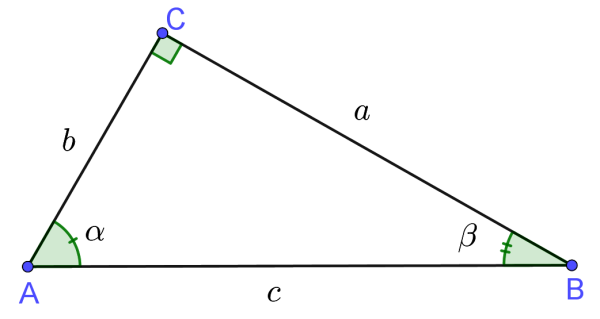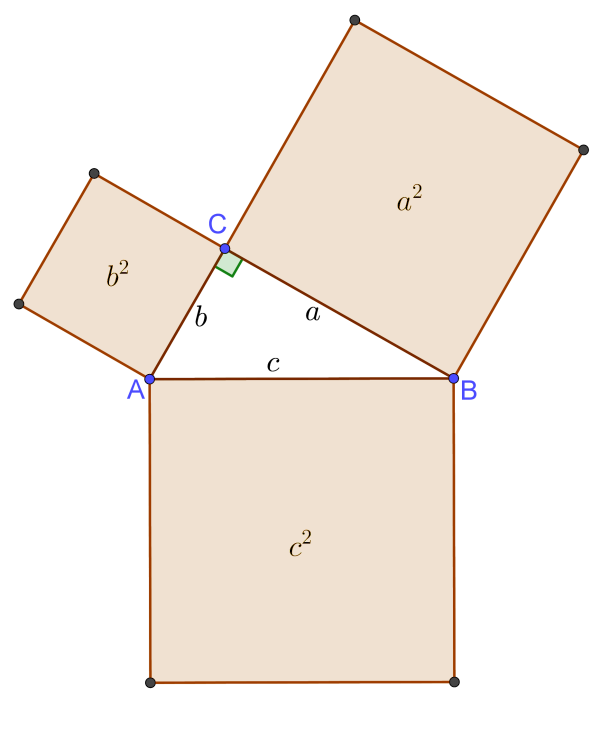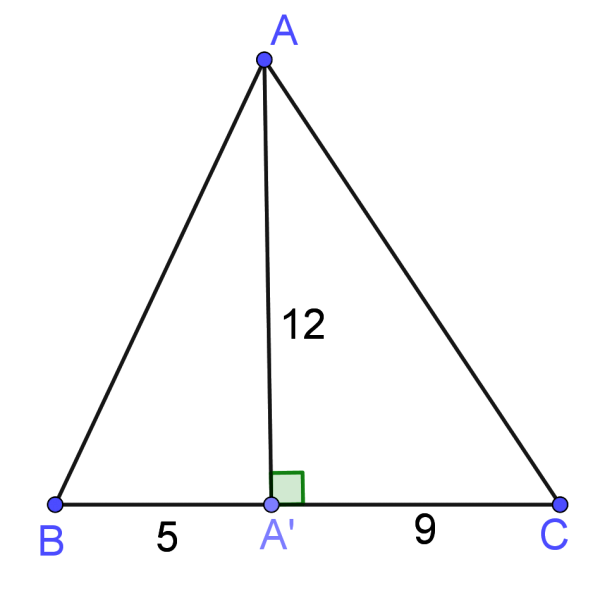Pythagorean Theorem Calculator
Pythagorean Theorem - work with steps
Input Data :
`a` = 3
`b` = 4
Objective :
Find the unknown length `c` of right triangle.
Formula :
`c = \sqrt(a^2 + b^2)`
Solution :
`c = \sqrt(3^2 + 4^2)`
` = \sqrt(9 + 16)^`
` = \sqrt(25)`
`c = 5`
Pythagorean Theorem calculator calculates the length of the third side of a right triangle based on the lengths of the other two sides using the Pythagorean theorem. In other words, it determines:
- The length of the hypotenuse of a right triangle, if the lengths of the two legs are given;
- The length of the unknown leg, if the lengths of the leg and hypotenuse are given.

It is necessary to follow the next steps:
- Enter the lengths of two sides of a right triangle in the box. These values must be positive real numbers or parameters. Note that the length of a segment is always positive;
- Press the "GENERATE WORK" button to make the computation;
- Pythagorean theorem calculator will give the length of the third side of a right triangle.
Output: A positive real number or variable as the length of the third side a right triangle $\Delta ABC$
Pythagorean Theorem Formula:
We must make sure that the length of the hypotenuse is labeled by $c$ and the lengths of the legs are labeled by $a$ and $b$.
If we know the length of the hypotenuse and the length of one leg, then the length of the other leg can be calculated by the formula $$a^2=c^2-b^2$$ or $$b^2=c^2-a^2$$
What is Pythagoras theorem?
One of the most famous and most useful theorems in mathematics is the Pythagoras Theorem. The theorem is named after the Greek mathematician Pythagoras because he gave its first proof, although no evidence of it exists.
Pythagorean Theorem: If $c$ is the length of the hypotenuse and $a$ and $b$ are the lengths of the legs in a right triangle,
then the square of the length of the hypotenuse is equal to the sum of the squares of the lengths of the legs, i.e.
$$c^2=a^2+b^2$$
Thus, if we know the lengths of two out of three sides in a right triangle, we can find the length of the third side. The Pythagorean Theorem can also be expressed in terms of area. In a right triangle, the area of the square on the hypotenuse is equal to the sum of the areas of the squares
on the two legs.


The converse of the Pythagoras Theorem is also valid. The Pythagorean converse theorem can help us in classifying triangles.
- If the square of the length of the longest side of a triangle is equal to the sum of squares of the lengths of the other two sides, then the triangle is a right triangle.
- If the square of the length of the longest side of a triangle is less than the sum of the squares of the lengths of the other two sides, then the triangle is an acute triangle.
- If the square of the length of the longest side of a triangle is greater than the sum of the squares of the lengths of the other two sides, then the triangle is an obtuse triangle.
How to Find a Unknown Side of a Right Triangle?
In a right triangle $\Delta ABC$, the length of the hypotenuse $c$ is equal to the square root of the sum of the squares of the lengths of the legs $a$ and $b$. That means,
Real World Problems Using Pythagorean theorem
The Pythagoras Theorem is widely applied in mathematics. The formula for finding distance between two points is based on the Pythagorean Theorem.
For any two points $A(x_A,y_A)$ and $B(x_B,y_B)$ in the two-dimensional Cartesian coordinate plane, the formula for distance between these points is derived from the Pythagorean Theorem, i.e.
In the theory of numbers, a triple $(a, b, c)$ consisted of three positive integers $a, b,$ and $c,$ which satisfies the Pythagorean formula
In the theory of complex numbers, the modulus $|z|$ of the complex number $z=a+ib$ is determined by
Pythagorean Theorem Practice Problems
Practice Problem 1:
A sail on a sailboat is in the shape of a right triangle. The length of the longest side of the sail is $220$ centimeters, and the length of the other side of the sail is $5$ meters.
Practice Problem 2:
Given a triangle $\Delta ABC$, as it is shown in the picture below. The altitude $\overline{AA'}$ divides the sides $\overline{BC}$ into
two segments ${BA'}=5$ and ${CA'}=9$. Find the perimeter of the triangle $\Delta ABC$.

Who invented Pythagorean Theorem?
Pythagorean theorem was invented by the Greek mathematician Pythagoras because he gave its first proof, although no evidence of it exists.
How do you calculate unknown or missing side of right triangle?
The length of unknown third side of right triangle can be found by using Pythagoras theorem. a = √(c^2 - b^2) is the formula to find the length a:, b = √(c^2 - a^2) is the formula to find the length b: and c = √(a^2 + b^2) is the formula to find the length c:.
What are the rules of Pythagoras?
The square of the length of the longest side of a triangle should be equal to the sum of squares of the lengths of the other two sides.
How do you solve a and b in Pythagorean theorem?
To find a: using Pythagorean theorem,
- find the square value of side b.
- find the square value of side c.
- Subtract b^2 from c^2.
- Find the root square value of the difference is the value of a.
To find b: using Pythagorean theorem,
- find the square value of side c.
- find the square value of side a.
- Subtract c^2 from a^2.
- Find the root square value of the difference is the value of b.
What is the hypotenuse calculator?
The tool which is used to find the long side of the right triangle is the hypotenuse calculator. Pythagorean theorem calculator is also known as hypotenuse calculator.
How do you make a^2+b^2 = c^2?
The equation a^2+b^2 = c^2 should be simplified further to find the unknown length of c. To simplify the equation, take the square root on both sides. The equation becomes √(a^2 + b^2) = c. Apply the values and find c:.
What is derived from the Pythagorean Theorem?
Pythagorean Theorem derives that the square of the length of the hypotenuse is equal to the sum of the squares of the lengths of the legs in a right triangle ΔABC.
When would you use Pythagorean theorem in real life?
In real life situations, we can use Pythagorean theorem to find the length of a ladder to reach top of the building from the place where you are standing nearby (for example, you are standing 25 yards away from the building).
